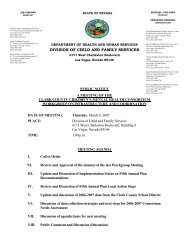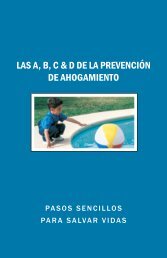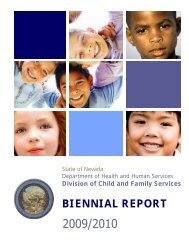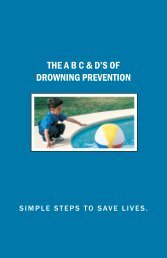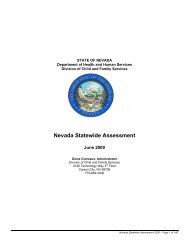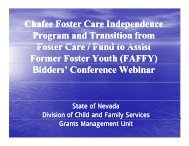STATE OF NEVADA - Division of Child and Family Services
STATE OF NEVADA - Division of Child and Family Services
STATE OF NEVADA - Division of Child and Family Services
You also want an ePaper? Increase the reach of your titles
YUMPU automatically turns print PDFs into web optimized ePapers that Google loves.
development <strong>of</strong> the brain for Indian children placed in non-Indian homes, the need for collaboration within Tribal child<br />
serving systems, <strong>and</strong> current implementation strategies for ICWA. Judge Thorne closed the session with a challenge<br />
for all Tribes to improve partnerships with State <strong>and</strong> county child welfare agencies. The Indian <strong>Child</strong> Welfare Track<br />
was attended by tribal chairs, tribal council members, Inter-Tribal Council <strong>of</strong> Nevada, Washoe County Department <strong>of</strong><br />
Social <strong>Services</strong>, DCFS Rural Region, tribal social services agencies, attorneys, court appointed special advocates,<br />
service providers, <strong>and</strong> other interested parties. There were more than 250 participants who were impacted by the<br />
information provided during the sessions.<br />
Systemic Factor G: Foster <strong>and</strong> Adoptive Home Licensing, Approval <strong>and</strong> Recruitment<br />
Item 41: St<strong>and</strong>ards for foster homes <strong>and</strong> institutions<br />
Goal: The State will ensure that implemented st<strong>and</strong>ards for foster family homes <strong>and</strong> child care institutions are reasonably<br />
in accord with recommended national st<strong>and</strong>ards.<br />
The first objective under this goal is that the State would engage in necessary regulation development to ensure quality<br />
st<strong>and</strong>ards for foster care <strong>and</strong> child care institutions, including the finalization <strong>of</strong> regulations related to NAC424 regarding<br />
treatment homes <strong>and</strong> NRS 432A regarding child care institutions. A second objective is that the State, in collaboration<br />
with the <strong>Child</strong> Welfare Agencies, will provide a mechanism for determining how effective foster family homes, child care<br />
institutions <strong>and</strong> facilities are at meeting required st<strong>and</strong>ards, including reporting on meeting corrective action for those<br />
homes or institutions that are not in compliance. A final objective, used to reach this goal is that the State will report on<br />
the length <strong>of</strong> time it takes to license foster <strong>and</strong> adoptive homes <strong>and</strong> facilities, including the number <strong>of</strong> waivers granted.<br />
For foster <strong>and</strong> adoptive homes, Nevada statutes in Chapter 424 – Foster Homes for <strong>Child</strong>ren provide a framework for the<br />
licensing, license renewal, inspections, investigations <strong>of</strong> foster homes <strong>and</strong> background investigations for foster care<br />
providers. Under NRS 424, the child welfare agencies have the responsibility for licensing foster homes, therefore the<br />
DCFS – Rural Region, CCDFS <strong>and</strong> WCDSS have the responsibility for licensing foster homes. This responsibility also<br />
includes monitoring <strong>and</strong> providing technical assistance to family foster <strong>and</strong> group foster homes. The purpose <strong>of</strong> licensing<br />
is to reduce the risk <strong>of</strong> harm to children in care. The licensing process determines whether the applicant can provide<br />
suitable care for children. To ensure that an acceptable level <strong>of</strong> care is maintained, licenses are renewed annually per<br />
NRS 424 with a minimum <strong>of</strong> one visit made to each licensed home. FBI checks are conducted on all applicants <strong>and</strong><br />
household residents 18 years <strong>of</strong> age <strong>and</strong> older.<br />
<strong>Family</strong> foster homes fall under NAC 424 regulations. The regulations incorporate definitions, general provisions, licensing<br />
<strong>and</strong> organizational requirements, requirements for qualifications <strong>and</strong> training <strong>of</strong> personnel <strong>and</strong> adult residents,<br />
requirements for initial training <strong>and</strong> ongoing annual training, specifications for facilities, ground <strong>and</strong> furnishings, <strong>and</strong><br />
operation <strong>of</strong> foster homes, including requirements for care, treatment <strong>and</strong> discipline <strong>of</strong> foster children. NAC 424<br />
regulations pertaining to licensing also specify st<strong>and</strong>ards for accessibility, facility space, immunization records, health <strong>and</strong><br />
sanitation, menus, food preparation, nutrition, fire safety <strong>and</strong> fire drill records, staff/child ratios, safety factors including<br />
pools <strong>and</strong> outdoor equipment, <strong>and</strong> transportation <strong>of</strong> children.<br />
For addressing st<strong>and</strong>ards related to child care institutions, the Bureau <strong>of</strong> <strong>Services</strong> for <strong>Child</strong> Care created workgroups <strong>and</strong><br />
amended proposed regulations to ensure Nevada’s children were in a safe <strong>and</strong> nurturing environment when placed in out<strong>of</strong>-home<br />
care. <strong>Child</strong> care institutions (educational, shelter care <strong>and</strong> residential) fall under NAC 432A regulations. The<br />
regulations incorporate definitions, training requirements, general requirements, social workers, maintaining records <strong>and</strong><br />
ratios. Licensing Surveyors complete quarterly, semi-annual <strong>and</strong> annual inspections (surveys) <strong>of</strong> facilities, such as facility<br />
files, indoor <strong>and</strong> outdoor deficiencies based on NRS 432A regulations. The regulations are based on fire, health, facility<br />
space, advertising, immunization <strong>of</strong> records, staff qualifications <strong>and</strong> training records, menu, food preparation, nutrition, fire<br />
drill records, staff/child ratios, safety factors including toys <strong>and</strong> outdoor equipment, transportation <strong>and</strong> discipline. Once<br />
deficiencies are noted, licensing surveyors will work with providers to come into compliance with the NRS 432A<br />
regulations. The proposed regulatory process is still in the progress working toward bringing the State <strong>of</strong> Nevada<br />
st<strong>and</strong>ards closer to National St<strong>and</strong>ards. During the last year’s Statewide Assessment <strong>and</strong> CFSR Process, stakeholders<br />
commenting on this item were in general agreement that DCFS <strong>and</strong> the local counties have implemented appropriate<br />
st<strong>and</strong>ards for foster family homes <strong>and</strong> child care institutions. Stakeholders reported that re-licensing occurs annually <strong>and</strong><br />
is done in a timely manner.<br />
In the Nevada 2009 CFSR Report, this item was rated as a strength. This continues to be an area <strong>of</strong> strength for Nevada.<br />
The number <strong>of</strong> foster homes in Nevada is increasing <strong>and</strong> the length <strong>of</strong> time to license homes is decreasing. Figure 17<br />
Nevada APSR – SFY 2010<br />
Page 79 <strong>of</strong> 108



